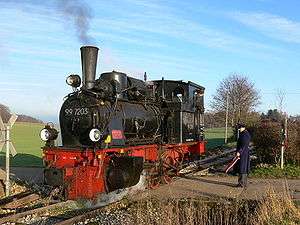Mosbach–Mudau Nos. 1 to 4
| Mosbach–Mudau Nos. 1 to 4 Baden C DRG Class 99.720 | |
|---|---|
 | |
| Number(s) | 1 - 4 DRG 99 7201-7204 |
| Quantity | 4 |
| Manufacturer | Borsig |
| Year(s) of manufacture | 1904 |
| Retired | 1964/1965 |
| Wheel arrangement | 0-6-0 |
| Axle arrangement | C n2t |
| Gauge | 1,000 mm |
| Length over buffers | 7,060 mm |
| Height | 3,600 mm |
| Width | 2,260 mm |
| Empty weight | 18 t |
| Service weight | 23 t |
| Axle load | 7.7 t |
| Top speed | 30 km/h |
| Indicated Power | 160 PS / 118 kW |
| Driving wheel diameter | 900 mm |
| Valve gear | Allan |
| No. of cylinders | 2 |
| Cylinder bore | 320 mm |
| Piston stroke | 420 mm |
| Boiler Overpressure | 12 bar |
| No. of heating tubes | 129 |
| Grate area | 1.78 m² |
| Tube heating area | 47.15 m² |
| Water capacity | 2,4 m³ |
| Fuel | 0.9 t coal |
| Locomotive brakes | Exter counterweight brake |
| Train brakes | Körting vacuum brake, later Westinghouse compressed-air brake |
| Couplers | Balancierhebelkupplung |
The Mosbach–Mudau engines Nos. 1 to 4 (or Baden C) were six-wheeled, narrow gauge, tank locomotives designed for the metre gauge line from Mosbach to Mudau.
History
The four locomotives were built in 1904 by the firm of Borsig. The frame was designed as a water tank. Due to the steep inclines it had a large boiler, the boiler barrel consisting of two shells.
It had an Allan valve gear with trick valves. The connecting rods drove the third coupled wheels. The loco had an Exter counterweight brake for the engine and a Körting vacuum brake for the train. This was probably replaced in 1926 by a Westinghouse compressed-air brake. When the Deutsche Reichsbahn took over the operational running of the state-owned by privately operated line from the Deutsche Eisenbahn-Betriebsgesellschaft, a subsidiary of the firm of Vering & Waechter who had built the line, these engines were incorporated into their fleet as numbers 99 7201 to 99 7204. In 1964/1965 the steam locomotives were retired and replaced by diesel locomotives. Until then they had managed all the traffic, no other locomotives were even employed in a temporary role.
Preserved
All the locomotives have been preserved until the present day.
- 99 7201 stood for a long time as a monument near Passau, before being acquired in 2007 by the Hirzbergbahn.
- 99 7202 is a monument at Mudau station.
- 99 7203 was used by the Albtalbahn from 1964 to 1966 for maintenance of way duties. It then went to the Karlsruhe gasworks and, later the Viernheim narrow gauge museum. Finally it ended up with the Ulmer Eisenbahnfreunde and has been in museum railway service since 1990 on the Amstetten–Oppingen line.
- 99 7204 was stored at Oberbernbach in Bavaria for a long time before being transferred in 1999 to the Märkische Museum Railway in Plettenberg.
Sources
- Josef Högemann: Schmalspurbahn Mosbach - Mudau.Verlag Kenning, Nordhorn 1993, (Nebenbahndokumentationen 5), ISBN 3-927587-15-X
- Horst J. Obermayer: Taschenbuch Deutsche Schmalspur-Dampflokomotiven. Franckh, Stuttgart 1971, ISBN 3-440-03818-1
- Alexander Neumann: 99 7201-7204. Vier Dampfloks begehen ihren Hundertsten. in: Die Museumseisenbahn 3/2004, S. 10-21. ISSN 0936-4609
See also
External links
- There is a relevant English-language forum at Railways of Germany